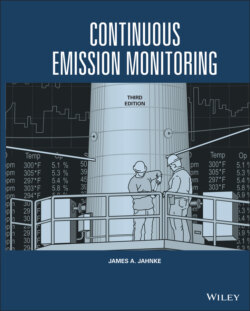Читать книгу Continuous Emission Monitoring - James A. Jahnke - Страница 86
Thermoelectric Coolers.
ОглавлениеHot flue gases can be cooled in thermoelectric Peltier coolers, which take advantage of the Peltier effect to chill the sample gas. The Peltier effect occurs when two dissimilar metals or semiconductors are joined in a loop and a voltage source generates a current through the loop. Because of the differing electron distributions in the dissimilar materials, a small voltage difference exits across their junction. The junction will heat up where the voltage difference opposes the voltage difference of the battery. At the other junction, thermal energy is absorbed from the surroundings and converted into electrical energy to balance the electron flow. This absorption, of course, reduces the temperature of the surroundings.
Semiconductor thermoelectric Peltier coolers are used in many commercial sample conditioning systems. Typically, impingers (laminar flow heat exchangers (Figure 3‐10)) are enclosed by a heat transfer block, which is contacted and cooled by a Peltier plate (Baldwin 1995). Radiator fins and a cooling fan dissipate heat from the hot side of the Peltier element.
In the impinger, the flue gas flows through the central tube, which is surrounded by a vacuum jacket. The flue gas remains above the dew point until it reaches the bottom where it is cooled rapidly. Water vapor condenses and is removed at the bottom of the impinger by typically using a peristaltic pump. The gas is cooled further by the cool impinger wall as it moves up to the impinger outlet. In a unique feature of the design, the gas is reheated by the unjacketed part of the central tube before exiting to the analyzer.
The effectiveness of this type of cooler is dependent upon the surface area and length of the impinger, gas flow rate, materials of construction, temperature of the ambient air, and the cold side temperature. The sizing of a Peltier cooler/impinger condensation system is dependent upon the demands of the total sampling system, so care must be taken in their proper application. The chillers normally operate to output a gas having a dew point of 4 °C (0.5% moisture concentration), but subzero coolers are available down to −25 °C to reduce the residual moisture concentration and to prevent the formation of acid gases such as SO3.
Figure 3‐10 Impinger (laminar heat exchanger) used with a Peltier cooling system.
